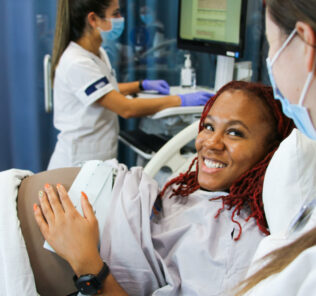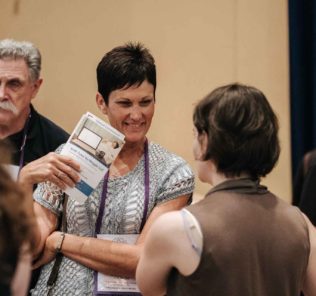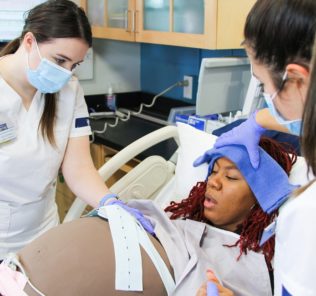Avkin’s Virtual Standardized Patients Help Prepare Next-Gen Workforce
To correctly prepare learners for the physical, emotional, psychological and ethical challenges they may encounter in the field, some healthcare simulation educators have begun to implement virtual standardized patient solutions. Helping to provide these solutions, the technology company Avkin has developed virtual standardized patients that include real humans. This realistic environment brings together the best of in-situ clinical simulations and augmented reality scenarios to continue the learning, despite restriction factors such as COVID-19. CEO and founder, Amy Cowperthwait, RN, APRN, CHSE, warns that if educators fail to properly prepare the next-gen workforce, the healthcare system could fail altogether as new professionals experience burnout and disillusionment at warp speed.
The benefits of using SPs in a live healthcare simulation include the element of human touch. Quite simply, human interaction makes the clinical simulation more aligned to real life. While medical simulation manikins can teach learners how to do simple skills, they cannot compare to working with a real person in a real bed. Utilizing simulated participants allows learners to more thoroughly develop critical thinking skills that are key to effective patient-centered, compassionate care.
During Avkin’s virtual SP simulation solutions for live patient interactions, each healthcare simulation is tailored to an institution’s needs. Utilizing Avkin’s simulated/standardized patients also allows institutions to save time and money. The virtual solutions begin with a facility or institution working with Avkin to build their custom healthcare simulation, followed by the need for the institution to schedule learners and prepare faculty members to use the resource. Next, the facility will approve the healthcare simulation and attend a dry run. Lastly, they can log in to Zoom with their learners and begin the clinical simulation.
Sponsored Content:
Along with the custom healthcare simulation specific to their curriculum, educators employing the virtual SP solution will be presented with guidelines for the clinical simulation faculty. They will also be provided with high-quality patients ready for simulation. With feedback from the patient’s perspective, facilitators will be able to optimize learning outcomes while maintaining happy and engaged learners!
For example, according to Avkin, 100% of learners who engaged with the virtual SP solution felt empowered to make clinical decisions, and 95% felt they improved their clinical decision-making skills using the platform. Additionally, 100% of learners reported feeling more confident communicating with a patient.
Cognitive and affective learning domains that the virtual standardized patient solution caters to include psychiatry, maternity, primary care, diversity, patient teaching, pharmacology, pediatrics, community nursing and interprofessional. Products that work well with simulated patients include those that focus on increasing the realism of the learning experience. The ability for a healthcare simulation to replicate real life through the use of devices, equipment and environment all aid in creating the most realistic simulation experience possible for learners.
“Telesimulation with trained simulated participants is the perfect alternative to impersonal, asynchronous avatar-based healthcare simulations that may be falling flat for your learners. Through a little creativity and imagination, virtual learning can transform SP simulation learning experiences into a virtual clinical experience for groups of one to ten learners,” said Cowperthwait. “Experts in SP methodology at Avkin have applied the Standards of Best Practice and elevated virtual simulation learning to a completely new level and we are excited to share the qualitative and quantitative educational outcomes we have measured at several colleges and universities during Fall 2020.”
Sponsored Content:
More About Avkin
Avkin is a manufacturer of wearable devices for use across healthcare simulation as a consultant for standardized patient programs. Founded in 2015 by Amy Cowperthwait, a nurse educator herself, Avkin provides a clinical simulation solution that combines the best of high-fidelity manikins and the realism of standardized patients for the most authentic medical simulation experience possible.
Headquartered in Wilmington, Delaware, Avkin believes that the key to success in patient-centered care is practitioner training through realistic simulations and that human interaction is irreplaceable in healthcare education. Avkin’s sensor-enabled, wearable technology (i.e., simulated mucus, simulated blood and simulated urine) uses haptic feedback to enable a new class of healthcare simulation training that teaches both the art (soft skills) and science (hard skills) required from practitioners like physicians, nurses and first responders.
Rooted in the Latin words, “akin” and “vera,” Avkin is a combination of the two. With Akin meaning “of similar character,” and vera meaning “truth,” our goal has always been to create the best quality products that allow for education to be “of similar character” and “true” to what the learners will experience in real life.
Learn More About Avkin’s Virtual Standardized Patient Solution!
Today’s article was guest authored by Amy Cowperthwait, RN, APRN, CHSE, founder and CEO of Avkin.
Have a story to share with the global healthcare simulation community? Submit your simulation news and resources here!
Lance Baily, BA, EMT-B, is the Founder / CEO of HealthySimulation.com, which he started in 2010 while serving as the Director of the Nevada System of Higher Education’s Clinical Simulation Center of Las Vegas. Lance also founded SimGHOSTS.org, the world’s only non-profit organization dedicated to supporting professionals operating healthcare simulation technologies. His co-edited Book: “Comprehensive Healthcare Simulation: Operations, Technology, and Innovative Practice” is cited as a key source for professional certification in the industry. Lance’s background also includes serving as a Simulation Technology Specialist for the LA Community College District, EMS fire fighting, Hollywood movie production, rescue diving, and global travel. He and his wife live with their two brilliant daughters and one crazy dachshund in Las Vegas, Nevada.
Sponsored Content:


















